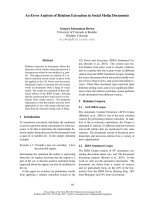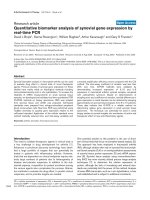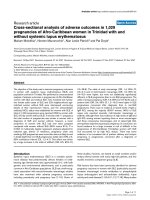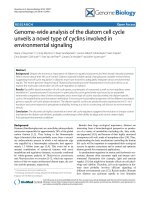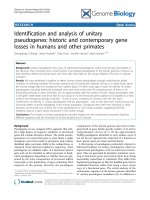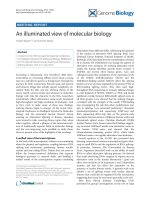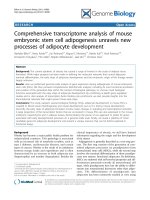Báo cáo y học: "An outcome analysis of self-expandable metallic stents in central airway obstruction: a cohort study" pptx
Bạn đang xem bản rút gọn của tài liệu. Xem và tải ngay bản đầy đủ của tài liệu tại đây (429.25 KB, 8 trang )
RESEARCH ARTICLE Open Access
An outcome analysis of self-expandable metallic
stents in central airway obstruction: a cohort
study
Fu-Tsai Chung
1,2†
, Hao-Cheng Chen
1†
, Chun-Liang Chou
1†
, Chih-Teng Yu
1
, Chih-Hsi Kuo
1
, Han-Pin Kuo
1
and
Shu-Min Lin
1*
Abstract
Background: Self-expandable metallic stents (SEMSs) have provided satisfactory management of central airway
obstruction. However, the long-term benefits and complications of this management modality in patients with
benign and malignant obstructing lesions after SEMS placement are unclear. We performed this cohort study to
analyze the outcomes of Ultraflex SEMSs in patients with tracheobronchial diseases.
Methods: Of 149 patients, 72 with benign and 77 with malignant tracheobronchial disease received 211 SEMSs
(benign, 116; malignant, 95) and were retrospectively reviewed in a tertiary hospital.
Results: The baseline characteristics of patients who received SEMS implantation for benign conditions and those
who underwent implantation for malignant conditions were sig nificantly different. These characteristics included
age (mean, 63.9 vs. 58; p < 0.01), gender (male, 62% vs. 90%; p < 0.0001), smoking (47% vs. 85%; p < 0.0001),
forced expiratory volume in 1 second (mean, 0.9 vs. 1.47 L/s; p < 0.00 01), follow-up days after SEMS implantation
(median; 429 vs. 57; p < 0.0001), and use of covered SEMS (36.2% vs. 94.7%; p < 0.0001). Symptoms improved more
after SEMS implantation in patients with benign conditions than in those with malignant conditions (76.7% vs.
51.6%; p < 0.0001). The overall complication rate after SEMS implantation in patients with benign conditions was
higher than that in patients with malignancy (42.2% vs. 21.1%; p = 0.001). Successful management of SEMS
migration, granulation tissue formation, and SEMS fracture occurred in 100%, 81.25%, and 85% of patients,
respectively.
Conclusions: Patients who received SEMS impla ntation owing to benign conditions had worse lung function and
were older than those who received SEMS for malignancies. There was higher complication rate in patients with
benign conditions after a longer follow-up period owing to the nature of the underlying diseases.
Introduction
Patients with symptomatic central airway lesions can be
treated with surgery or endoscopic intervention [1-3].
Owing to advances in endobronchial stents and insertion
techniques, interventional bronchoscopic procedures
have been widely used in patients with benign and malig-
nant lesions [4-7]. Rigid and flexible bronchoscopies are
the most common methods of stent implantation in
these patients. Some patients are not candidates for sur-
gical intervention or rigid bronchoscopy with a general
anaesthetic, however, because of illness s everity and
comorbidities. Self-exp andable metallic stents (SEMSs)
can be successful ly implanted with a flexib le broncho-
scope while the patient receives conscious sedation and a
local anaesthetic [8-10]. Patients who are i neligible for
surgical procedures or rigid bronchoscopy may undergo
SEMS implantation to relieve their symptoms [11].
Although SEMSs provide satisfactory management of
central airway obstruction in large tracheobronchial dis-
eases, they are accompanied by complications such as
migration, granulation tissue formation, impaired
* Correspondence:
† Contributed equally
1
Department of Thoracic Medicine, Chang Gung Memorial Hospital, Chang
Gung University, College of Medicine, No. 199 Tun Hwa N. Rd., Taipei City
10507, Taiwan
Full list of author information is available at the end of the article
Chung et al. Journal of Cardiothoracic Surgery 2011, 6:46
/>© 2011 Chung et al; licensee BioMed Central Ltd. This is an Open Access article distributed under the terms of the Creative Commons
Attribution License (http://c reativecommons.org/licenses/by/2.0), which permits unrestricted use, distribution, and reproduction in
any medium, prov ided the orig inal work is properly cited.
mucociliary clearance, recurrent lumen obstruction of
the stent, and increased bacterial colonization [12-14].
Because of potentially hazardous complications, the US
Food and Drug Administration (FDA) has warned that
SEMS implantation should be considered only in
patients who are ineligible for surgery, rigid broncho-
scopy, or silicone stent implantation. However, previous
studies [10,15] have concluded that SEMSs are useful
management options for central airway obstruction in
patients with benign and malignant diseases. The bene-
fits and complications of SEMS placement i n patients
with benign obstructing lesions are unclear in the avail-
able medical literature.
This study was designed to investigate the long-term
outcomes of patients with airway obst ruction who
received SEMSs. Most of the patients received an SEMS
before the FD A warning about the placement of SEMSs
in patients with benign airway obstruction. The goal of
this study was to analyze the base line characteristics,
clinical features, overall symptomatic response, and
complication rate after SEMS placement in patients with
benign and malignant central airway obstructions. The
management of SEMS-related complications was also
investigated.
Patients and Methods
Design
This investigation was a retrospective study. Informed
consents were obtained from all p atients or their surro-
gates before bronchoscopic SEMS implantation and fol-
low-up. Methodology and patient confidentiality were
approved by our institutional review board (IRB). The
IRB w as also asked to r eview the design of the project
in December 2006, and it approve d this retrospective
study in March 2007 (IRB No.: 98-3287B). The IRB con-
firmed that this study constituted an audit, which did
not require patient consents.
Patients
From August 2001 to March 2007, 149 patients (mean
age ± standard deviation, 62.1 ± 15.4; range, 23-91)
underwent 211 endoscopic airway stent placements at
Chang Gung Memorial Hospital, a university-affiliated
hospital in Taiwan. In total, 116 stents were used in 72
patients with benign tracheobronchial disease and 95
stents were used in 77 patients with malignancy. Thor-
acic surgeons were routinely consulted for the feasibility
of surgical intervention or rigid bronchos copy in all
patients before SEMS implantation. If patients were
unsuitable for surgical intervention owing to poor lung
function, co-morbidities, or refusal to undergo surgery,
SEMS implantation with fibre-optic bronchoscopy was
used if other treatment options were unavailable. The
development of new or progressive symptoms was
closely monitored, and follow-up radiographic and
bronchoscopic examinations were arranged.
Stent implantation
Ultraflex (Boston Scientific, Natick, MA), a tightly
woven, self-ex pandable metallic stent composed entirely
of a single strand of nickel-titanium alloy, was the stent
of choice for this study. Central airway stenosis was
evaluated using chest computed tomography (CT) and
bronchoscopy [16-18]. The principles of SEMS implan-
tation in our institution under conscious sedation and
local anaesthesia and the assessment of stent condition
have been reported in previous studies [16,17]. The
choice of stent length and type (with or without cover)
was made according to previous endoscopic examination
and chest CT scan. SEMSs were implanted at the choke
point determined using a flow-vol ume curve, endobron-
chial ultrasonography, bronchosco py, or three-dimen-
sional CT before and after stenting [18,19].
Stents types (length, diameter, and covered or uncov-
ered) were selected according to CT scan, broncho-
scopic image, and physician choice. Covered stents were
usually used in patients with malignant diseases to cover
the tumour mass in the airway. Only 5 patients with
malignancy received uncovered stents because of the
critical location of t he implanted stent. Tumours of the
main bronchi near the main carina caused narrowing of
the main bronchial orifices. Covered stent placement
could reopen obstructed main bronchial orifices but
risked covering the other main bronchial orifice. Uncov-
ered stents were usually se lected in patients with benign
diseases for feasibility of stent removal, especially in the
bronchial airway.
Assessment of stent condition
A follow-up bronchoscopy was performed 48 hours after
stent placement. The presence of incomplete stent
expansion or an incomplete stented airway lumen was
recorded so that post-procedure factors could be evalu-
ated in follow-up bronchoscopic studies. In addition,
each patient underwent bronchoscopic examination 1
week after implantation and every 3- 6 months thereafter
to evaluate stent position and degradation, granulation
tissue formation, and a irway alignment. If new or pro-
gressive symptoms including dyspnoea, severe cough,
increased mucous production, or other symptoms that
suggested stent fracture occurred, additional broncho-
scopy was performed.
Definition of SEMS complications
All possible complications related to SEMS placement
were confirmed with bronchoscopic examination.
According t o p atients’ records, complic ations included
stent migration, granulation tissue formation, stent
Chung et al. Journal of Cardiothoracic Surgery 2011, 6:46
/>Page 2 of 8
fracture, and pneumothorax. SEMS fracture was defined
as physical breakage [16,17].
Successful management was defined as the relief of
complications without the need for additional proce-
dures during the follow-up period. A total of 5 patients
with SEMS migration lacked significant symptoms and
required no further management. These patients were
considered successfully managed but were included in
the analysis of stent migration.
Statistical analysis
Data are expressed as either group percentages (catego-
rical variables) or mean ± SD (continuous variables).
Time variables are expressed as median and interquar-
tile range (IQR). Data were compared between patients
with benign and patients with malignant conditions.
Categorical variables were compared using the chi
square or Fisher’s exact test. Unpaire d t-tests were used
to compare continuous variables. The significant differ-
ence between the 2 groups was defined as a p value less
than 0.05. All analyses were performed using SPSS soft-
ware v. 10.0 (SPSS, Chicago, IL).
Results
From August 2001 to March 2007, 149 patients (mean
age ± standard deviation, 61.2 ± 15.7 years; range, 23-
91) with ben ign (n = 72) and malignant (n = 77) tra-
cheobronchial disease receiv ed 211 Ultraflex S EMSs
(116 for benign conditions and 95 for malignant condi-
tion). The indications for SEMS implantation are listed
in Table 1.
The demographic s of patients who underwent SEMS
placement, including those with benign and malignant
disease, are listed in Table 2. Patient characteristics
between the benign and malignant airway obstruction
groups were significantly different. These characteristic s
included age (63.9 ± 15.6 years vs. 58 ± 12.2 years; p =
0.006), gender (male, 62.1% vs. 90.5%; p<0.0001), smok-
ing (47.4% vs. 85.3%; p<0.0001), forced expiratory
volume in 1 second 0.9 ± 0.4 L/s vs. 1.47 ± 0.68 L/s; p <
0.0001), follow-up days after SEMS placement (median
(IQR); 429 (141-856) vs. 57 (19-103); p < 0.0001), and
use of covered SEMS (36.2% vs. 94.7%; p<0.0001). The
clinical presentation was significantly different in
patients with benign airway obstruction when compared
with patients with malignant disease. This presentation
included dyspnoea (95.7% vs. 48.4%; p<0.0001), cough
(1.7% vs. 21.1%; p<0.0001), respiratory failure (2. 6% vs.
17.9%; p = 0.0002), pneumonia (0% vs. 9.5%; p = 0.0007)
and haemoptysis (0% vs. 3.2%; p = 0.05).
The clinical responses and complications after SEMS
placement in patients with benign airway obstruction
and malignant disease are listed in Table 3. Patients
with benign airway obstruction had a clinical response
after SEMS placement that was significantly better than
that of patients with malignant disease (76.7% v s. 51.6%;
p < 0.0001). The overall complication rate (42.2% vs.
21.1%; p=0.001) after SEMS implantation was higher
in patients with benign conditions than in patients with
malignancy. The 30-day complication rate (4.3% vs.
9.5%; p = 0.13) and the 60-day complication rate (8.6%
vs. 15.8%; p = 0.11) related to SEMS placement were
similar in both groups. Complications in patients wit h
malignant airway obstruction presented earlier than
those in patients with benig n conditions (median, IQR;
211, 52-686 days vs. 33, 19-35 days; p = 0.0002).
Table 4 summarizes the complication rates and the
time to detect complications after SEMS implantation.
The complication rates after SEMS implantation, includ-
ing stent migration (6.9% vs. 8.4%; p = 0.68), granulation
tissue formation (19% vs. 10.5%; p =0.09),andpneu-
mothorax (0% vs. 1.1%; p=0.27), were similar in
patients with benign conditions and those with malig-
nant conditions. The fracture of SEMSs was significantly
more frequent in patients with benign airway obstruc-
tion than in patients with malignant disease (16.4% vs.
Table 1 Indications for SEMS placement
Conditions Number of
patients
Number of
SEMSs
Malignant diseases
Primary lung cancer with airway invasion
NSCLC 35(45.4) 45(47.3)
SCLC 7(9.1) 7(7.4)
Carcinoid 1(1.3) 2(2.1)
Sacrcoma 1(1.3) 1(1.1)
Oesophageal cancer
TE fistula 24(31.2) 31(32.6)
Tracheal stenosis for
tumour invasion
3(3.9) 3(3.2)
Other malignancy with trachea
invasion
2(2.6) 2(2.6)
Mediastinal mass compression 4(5.2) 4(5.2)
Subtotal 77 95
Benign diseases
Malacia 29(40.3) 64(55.2)
Post-intubation stenosis 9(12.5) 11(9.5)
Post-TB stenosis 9(12.5) 11(9.5)
Granulation restenosis 9(12.5) 13(11.2)
Stent fracture 6(8.3) 6(5.2)
Goiter 4(5.6) 4(3.4)
Corrosive injury 2(2.8) 3(2.6)
Mediastinitis 2(2.8) 2(1.7)
Tracheitis 2(2.8) 2(1.7)
Subtotal 72 116
Total 149 211
Abbreviations: NSCLC, non-small cell lung cancer; SCLC, small cell lung cancer;
SEMS, self-expandable metallic stent; TB, tuberculosis; TE, tracheo-oesophageal
Chung et al. Journal of Cardiothoracic Surgery 2011, 6:46
/>Page 3 of 8
1.1%; p < 0.0001). The time to detec t granulation tissue
formation after SEMS implantation in patients with
benign airway obstruction was longer than that in
patients wit h malignant conditions (median, IQR; 212,
59-489 d ays vs. 31, 19-35 days; p=0.005). The time to
detect SEMS migration was similar between the 2
groups.
Table 5 summarizes the complications and resolution
of symptoms after SEMS placement in patients with
benign disease who underwent covered stent placeme nt
and those who underwent uncovered stent placement.
The incidence of complications, including stent migra-
tion (9.5% vs. 5.4%; p = 0.458), granulation tissue forma-
tion (16.7% vs. 20.3%; p = 0.634), and stent fracture
(11.9% vs. 18.9%; p=0.44), was similar in both groups.
Resolution of symptoms after covered and uncovered
SEMS placement in patients with benign disease was
also similar (71.4% vs. 79.7%; p = 0.363).
The management and outcome of complications after
SEMS placement are listed in Table 6. In patients with
stent migration, obser vation (n = 5, 3 2.2%), reposition
(n = 4, 25%), placement of another stent (n = 3, 18.8%),
and stent removal (n = 4, 25%) were used to manage
this complicat ion. Granulation tissue formation relat ed
to SEMS placement (n = 32) was managed with
electrocautery (n = 12, 37.5%), balloon dilatation (n = 1,
3.1%), stent removal (n = 12, 37.5%), or implantation of
another stent (n = 7, 21.9%). Stent fracture (n = 20) was
managed with removal of the fractured stent (n = 10,
50%) or implantation of another stent (n = 5, 25%). In
total, 5 fractured stents (25%) resolved without interven-
tion owing to minimal protrusion of the stent wit h
patent lumen and preserved architecture. Successful
management of SEMS migration, granulation tissue for-
mation, a nd SEMS fracture o ccurred in 100%, 81.25%,
and 85% of patients, respectively.
Discussion
In patients with central airway obstruction that is not
amenable to surgery or that is medically inoperable,
airway stenting may be the only possible treatment
[20]. Silicone stents remain the first choice in benign
airway obstruction except in patients with a irway wall
malacia or distal/angular stenosis. In these patients,
SEMSs are generally i ndicated [21,22]. SEMSs have
been widely used in benign and malignant airway
obstruction and can be successfully implanted with a
flexible bronchoscope with conscious sedation and
local anaesthesia [9,10]. Unlike silicone stents, SEMSs
have advantages such as lower migration rate, greater
Table 2 Demographics of patients receiving SEMS placement
Total (n = 211) Benign (n = 116) Malignant (n = 95) p value¶
Demography
Age (yrs) 61.2 ± 15.7 63.9 ± 15.6 58.0 ± 15.2 0.006
Gender, Male, n(%) 158(74.9) 72(66.1%) 86(90.5) <. 0001
Smoking, n(%) 136(64.5) 55(47.4) 81(82.3) <. 0001
FEV1(L/s) 1.05 ± 0.55 0.90 ± 0.40 1.47 ± 0.68 <. 0001
SEMS follow up days, median(IQR) 130(39-550) 429(141-856) 57(19-103) <. 0001
Cover SEMS, n(%) 132(62.6) 42(36.2) 90(94.7) <. 0001
Clinical manifestation before SEMS implantation
Dyspnoea, n(%) 157(74.4) 111(95.7) 46(48.4) <. 0001
Cough, n(%) 22(10.4) 2(1.7) 20(21.1) <. 0001
Respiratory failure, n(%) 20(9.5) 3(2.6) 17(17.9) .0002
Pneumonia, n(%) 9(4.3) 0(0) 9(9.5) .0007
Haemoptysis, n(%) 3(1.4) 0(0) 3(3.2) 0.05
Abbreviations: FEV1, forced expiratory flow in 1 second; FVC, forced vital capacity; IQR, interquartile range; p value, benign group vs. malignant group; SEMS, self-
expandable metallic stent
Table 3 Summary of responses after SEMS implantation
Response Total (n = 211) Benign (n = 116) Malignant (n = 95) p value¶
Resolution of symptom, n(%) 138(65.4) 89(76.7) 49(51.6) <. 0001
Complication related to SEMS in 30 days, n(%) 14(6.6) 5(4.3) 9(9.5) 0.134
Complication related to SEMS in 60 days, n(%) 25(11.8) 10(8.6) 15(15.8) 0.109
Overall complications related to SEMS, n(%) 69(32.7) 49(42.2) 20(21.1) .0011
Time to complications developed, median (IQR) 87(33-435) 211(52-686) 33(15-59) .0002
Complication episode per patient per month 0.006 0.008 0.01 -
Abbreviations: IQR, Interquartile range; p value, benign group vs. malignant group; SEMS, self-expandable metallic stent
Chung et al. Journal of Cardiothoracic Surgery 2011, 6:46
/>Page 4 of 8
cross-sectional airway diameter owing to thinner wall
construction, better conformation to irregular airways,
epithelialization within the stent that allows for muco-
ciliary clearance, and a greater ease of placement [16].
Granuloma formation and stent fracture have been
reported around stents in benign airway obstruction
with a frequency of up to 14.6% and 12.2%, respec-
tively. It may be more common in patients wit h benign
airway obs tructions [10,16,17].
Our study demonstrated that patients with benign air-
way obstruction who underwent SEMS placement to
relieve symptoms had worse lung function and were
older compared with patients with malignant disease
who under went SEMS placement. Most of our p atients
with benign airway obstruction presented with dys-
pnoea, whereas patients with malignant airway obstruc-
tion presented with cough and/or respiratory failure.
We observed a higher SEMS complication rate in
patients with benign airway obstruction. Granuloma for-
mation and SEMS fracture, in particular, were more
common in patients with benign airway obstruction
compared with patien ts with maligna nt disease. This
was probably due to the longer period of time the stent
was present in the airway and exposure of the stent to
the natural environment and due to the excessive com-
pression-decompression cycles of the airway wall during
breathing and cough (stress fracture). Most complica-
tions were managed successfully and safely by experi-
enced bronchoscopists.
At our institute, surgical treatment in patients with
benign airway diseases is the first choice. If patients
were unsuitable for surgical intervention because of
poor lung function, comorbidities, or refusal to undergo
surge ry, conservative managem ent and close monitoring
are advised. SEMS placement is considered when
patients present with severe symptoms that affect quality
of life. The high incidence of dyspnoea at the time of
presentation in p atients with benign airway obstruction
may be explained by the poorer lung function, older
age, and increased comorbidities in these patients com-
pared with those with malignancy.
Presenting symptoms resolved in three-fourths of the
patients with benign airway obstruction and in half of
the patients with malignant airway obstruction after
SEMS placement. This difference is probably related to
the isolated involvement of the central airway in patients
with benign airway obstruction. Patients with malignant
airway obstruction likely had higher rates of lung par-
enchymal involvement because of tumours, lymphangitic
spread of malignancy , tumour emboli, and wasting syn-
dromes associated with malignancy, decreasing improve-
ment in presenting symptoms after SEMS placement.
SEMS fractures are not rare in patients with central
airway obstruction [16], and they were overall more
common in patients wit h benign airway obstructi on.
However, SEMS fracture rates were similar in patients
with benign airway obstruction a nd in patients with
malignant airway obstruction after 30 and 60 days of
Table 4 Complication rates and time to detect complications after SEMS placement
Total (n = 211) Benign (n = 116) Malignant (n = 95) p value¶
Complication rate
Stent migration, n(%) 16(7.6) 8(6.9) 8(8.4) 0.677
Granulation tissue formation, n(%) 32(15.2) 22(19.0) 10(10.5) 0.089
Stent fracture, n(%) 20(9.5) 19(16.4) 1(1.1) 0.0002
Pneumothorax, n(%) 1(0.5) 0(0) 1(1.1) 0.268
Time to detect complication after SEMS implantation (days)
Stent migration, n(%) 18(8-55) 45(9-109) 16(3-32) 0.112
Granulation tissue formation, n(%) 75(33-378) 212(59-489) 31(19-35) 0.005
Stent fracture, n(%) 652(306-814) 686(277-856) 515 -
Pneumothorax, n(%) 2 none 2 -
Abbreviations: –, unable to compare p value; p value, benign group vs. malignant group; SEMS, self-expandable metallic stent
Table 5 Complications and resolution of symptoms in patients with benign diseases after covered and uncovered
stent placement
Total (n = 116) Covered (n = 42) Uncovered (n = 74) p value¶
Complication rate
Stent migration, n(%) 8(6.9) 4(9.5) 4(5.4) 0.458
Granulation tissue formation, n(%) 22(19.0) 7 (16.7) 15(20.3) 0.634
Stent fracture, n(%) 19(16.4) 5(11.9) 14(18.9) 0.44
Resolution of symptoms, n(%) 89(76.7) 30 (71.4) 59 (79.7) 0.363
Abbreviations: p value, covered vs. uncovered stents; SEMS, self-expandable metallic stent
Chung et al. Journal of Cardiothoracic Surgery 2011, 6:46
/>Page 5 of 8
follow-up. Patients with malignancy-induced central air-
way obstruction were followed for a median of 57 days,
whereas patients with benign airway obstruction were
followed for 429 days. The short life expectancy in
patients with malignancy may be inadequate for the
development of long-term complications like granuloma
formation and stent fractures. Conversely, patients with
malignancy-induced central airway obstruction may
develop certain complications like granuloma formations
faster after SEMS placement compared with patie nts
who have benign airway obstructions. These complica-
tions may be related to the underlying malignancies.
Dougla s E. Wood reported that uncovered stents have
the theoretical benefit of neo-epithelialization with
incorporation of the stent into the airway wall and that
this incorporation is permanent and, once the stent is
seated, repositioning or removal is nearly impossible.
This neo-epithelialization maybeespeciallytroubling
when tumo ur ingrowth or granulation tissue produces
recurrent obstruction inside the stent [20]. Our data do
not support this observation because the stent type had
been selected when placement. Most patients with
benign disease in our study had airway malacia, and we
selected uncovered stents. Nevertheless, t here were no
significant differences in complications and resolution of
symptoms between patients with benign airway obstruc-
tions who underwent covered stent placement and those
who underwent uncovered stent placement (Table 5).
The overall complication rates in our study are similar
to those reported i n previous studies [10,16,17]. S EMS-
related granulation tissue formation and stenosis can be
managed with a variety of flexible bronchoscopic
interventions including electrocautery, cryotherapy, laser
photocoagulation, radiofrequency ablation, and stent
removal (when necessary). In our report, manag ement
of SEMS-related complications was feasible, and the
success rate was more than 80%. However, such inter-
ventions for SEMS-related complications require experi-
enced bronchoscopists who are familiar with techniques
like electrocautery, balloon dilation, cryotherapy, and
other interventional pulmonary procedures. Patients
who require SEMS placement must be monitored clo-
sely for related complications.
Notwithstanding our use of the Ultraflex stents in
carefully selected patients, silicon stents remain the first
choice in patients with benign airway obstruction. Sili-
cone stents with defined diameter can be repositioned
and removed easily. In addition, silicon stents have little
tissue reactivity, and minimal granulations form after
placement. Because of the solid character of these stents,
little tumour ingrowth or granulatio n was found after
placement. Silicone stents also can be easily modified by
cutting a portion of the stent to allow customization to
airway anatomy [20]. In our hospital, patients with
benign airway narrowing were evaluated to receive sur-
gical treatment or silicon stent placement first.
Our study has some limitations. First, we did not per-
form a controlled study for airway stents; however, we did
not find any obvious diversity signifying that airway stent-
ing did not worsen the survival. Blinded, randomized, and
controlled trials are hard to perform in these subjects
owing to the practices. Second, SEMS placement was not
recommended in patients with benign disease after the
FDA warning in 2007. However, most of th e SEMSs in
Table 6 Management and outcomes of SEMS-related complications
Complication Management Total, n(%) Successful management, n(%)
Migration
None 5(32.2%) 5(32.5%)
Reposition 4(25%) 4(25%)
Another SEMS stenting 3(18.8%) 3(18.8%)
SEMS removal 4(25%) 4(25%)
Subtotal 16(100%) 16(100%)
Granulation tissue formation
Electrocautery only 12(37.5%) 9(28.1%)
Balloon dilatation 1(3.1%) 1(3.1%)
SEMS removal 12(37.5%) 11(34.5%)
Another SEMS stenting 7(21.9%) 5(15.6%)
Subtotal 32(100%) 26(81.25%)
Stent fracture
None 5(25%) 5(25%)
SEMS removal 10(50%) 9(45%)
Another SEMS stenting 5(25%) 3(15%)
Subtotal 20(100%) 17(85%)
Abbreviation: SEMS, self-expan dable metallic stent
Chung et al. Journal of Cardiothoracic Surgery 2011, 6:46
/>Page 6 of 8
our study were placed before 2007, and we sought to pro-
vide an outcome analysis for these subjects. We selected
patients with benign disease according to poor lung func-
tion, comorbidities, and refusal to undergo surgery. The
placement of an SEMS did improve most respiratory
symptoms and signs in patients in this study and made
further treatment possible. Finally, the factors that contri-
bute to complications may be too complex to analyze even
though our study revealed a higher rate of stent fracture
and granulation formation after SEMS placement in
patients with benign diseases.
Conclusion
Surgical intervention should be the initial management
option for patients who develop benign central airway
obstruction and are otherwise surgical candidates. Airway
prostheses including silicone stents or SEMS could be
considered to treat symptoms in patients who are poor
surgical candidates, at prohibit ive risk for general anaes-
thesia, or have refused surgery. SEMSs could be placed
under flexible bronchoscopy and conscious sedation with
minimal immediate procedure-related complications.
SEMSs are also reasonable management op tions for the
palliation of sympto matic central airway obstruction
related to malignancy. Our experience confirms that the
use of SEMSs for benign severe central airway obstruc-
tion should be restricted to the treatment of severe symp-
toms in highly selected patients who are not surgical
candidates, refuse sur gery, or are at prohibit ive risk for
immediate complications after rigid bronchoscopy and
related anaesthesia (which is required to place silicone
stents). This procedure should be underta ken in these
patients only after they consent to the procedure and
understand the potential co mplications, which include
serious morbidity and potential mortality. Interventional
pulmonary techniques can be used with reasonable suc-
cess to address some SEMS-related complications.
List of abbreviations used
SEMSs: Self-expandable metallic stents; IRB: institutional review board; IQR:
interquartile range; FDA: US Food and Drug Administration
Acknowledgements
This study was partly supported by a grant from the Chang Gung Memorial
Hospital Medical Research Project (CMRPG391211).
Author details
1
Department of Thoracic Medicine, Chang Gung Memorial Hospital, Chang
Gung University, College of Medicine, No. 199 Tun Hwa N. Rd., Taipei City
10507, Taiwan.
2
Graduate Institute of Clinical Medical Sciences, College of
Medicine, Chang Gung University, No. 259, Wun Hua 1st Rd., Gueishan
Township, Taoyuan County 333, Taiwan.
Authors’ contributions
FTC and SML developed the idea for this manuscript and wrote it. FTC, HCC,
and CLC performed the procedures. FTC, CTY, CHK, and HPK collected and
analyzed the data. All authors read and approved the final manuscript.
Competing interests
The authors declare that they have no competing interests.
Received: 9 October 2010 Accepted: 8 April 2011 Published: 8 April 2011
References
1. Seijo LM, Sterman DH: Interventional pulmonology. N Engl J Med 2001,
344:740-749.
2. Bolliger CT, Mathur PN, Beamis JF, Becker HD, Cavaliere S, Colt H, Diaz-
Jimenez JP, Dumon JF, Edell E, Kovitz KL, Macha HN, Mehta AC, Marel M,
Noppen M, Strausz J, Sutedja TG: ERS/ATS statement on interventional
pulmonology. European Respiratory Society/American Thoracic Society.
Eur Respir J 2002, 19:356-373.
3. Brichet A, Verkindre C, Dupont J, Carlier ML, Darras J, Wurtz A, Ramon P,
Marquette CH: Multidisciplinary approach to management of
postintubation tracheal stenoses. Eur Respir J 1999, 13:888-893.
4. Al-Kattan K, Simonds A, Chung KF, Kaplan DK: Kyphoscoliosis and
bronchial torsion. Chest 1997, 111:1134-1137.
5. Colt HG, Harrell JH: Therapeutic rigid bronchoscopy allows level of care
changes in patients with acute respiratory failure from central airways
obstruction. Chest 1997, 112:202-206.
6. Shaffer JP, Allen JN: The use of expandable metal stents to facilitate
extubation in patients with large airway obstruction. Chest 1998,
114:1378-1382.
7. Noppen M, Stratakos G, Amjadi K, De Weerdt S, D’Haese J, Meysman M,
Vincken W: Stenting allows weaning and extubation in ventilator or
tracheostomy dependency secondary to benign airway disease. Respir
Med 2007, 101:139-145.
8. Hautmann H, Bauer M, Pfeifer KJ, Huber RM: Flexible bronchoscopy: a safe
method for metal stent implantation in bronchial disease. Ann Thorac
Surg 2000, 69:398-401.
9. Madden BP, Datta S, Charokopos N: Experience with Ultraflex expandable
metallic stents in the management of endobronchial pathology. Ann
Thorac Surg 2002, 73:938-944.
10. Saad CP, Murthy S, Krizmanich G, Mehta AC: Self-expandable metallic
airway stents and flexible bronchoscopy: long-term outcomes analysis.
Chest 2003, 124:1993-1999.
11. Madden BP, Loke TK, Sheth AC: Do expandable metallic airway stents
have a role in the management of patients with benign
tracheobronchial disease? Ann Thorac Surg 2006, 82:274-278.
12. Zakaluzny SA, Lane JD, Mair EA: Complications of tracheobronchial airway
stents. Otolaryngol Head Neck Surg 2003, 128:478-488.
13. Gaissert HA, Grillo HC, Wright CD, Donahue DM, Wain JC, Mathisen DJ:
Complication of benign tracheobronchial strictures by self-expanding
metal stents. J Thorac Cardiovasc Surg 2003, 126:744-747.
14. Noppen M, Mossman M, Claes I, D’Haese J, Vincken W: Screw-thread vs
Dumon endoprosthesis in the management of tracheal stenosis. Chest
1999, 115:532-535.
15.
Husain SA, Finch D, Ahmed M, Morgan A, Hetzel MR: Long-term follow-up
of ultraflex metallic stents in benign and malignant central airway
obstruction. Ann Thorac Surg 2007, 83:1251-1256.
16. Chung FT, Lin SM, Chen HC, Chou CL, Yu CT, Liu CY, Wang CH, Lin HC,
Huang CD, Kuo HP: Factors leading to tracheobronchial self-
expandable metallic stent fracture. J Thorac Cardiovasc Surg 2008,
136:1328-1335.
17. Chung FT, Lin SM, Chou CL, Chen HC, Liu CY, Yu CT, Kuo HP: Factors
leading to obstructive granulation tissue formation after ultraflex
stenting in benign tracheal narrowing. Thorac Cardiovasc Surg 2010,
58:102-107.
18. Koletsis EN, Kalogeropoulou C, Prodromaki E, Kagadis GC, Katsanos K,
Spiropoulos K, Petsas T, Nikiforidis GC, Dougenis D: Tumoral and non-
tumoral trachea stenoses: evaluation with three-dimensional CT and
virtual bronchoscopy. J Cardiothorac Surg 2007, 2:18-24.
19. Miyazawa T, Miyazu Y, Iwamoto Y, Ishida A, Kanoh K, Sumiyoshi H, Doi M,
Kurimoto N: Stenting at the flow-limiting segment in tracheobronchial
stenosis due to lung cancer. Am J Respir Crit Care Med 2004,
169:1096-1102.
20. Wood DE, Liu YH, Vallieres E, Karmy-Jones R, Mulligan MS: Airway stenting
for malignant and benign tracheobronchial stenosis. Ann Thorac Surg
2003, 76:167-174.
Chung et al. Journal of Cardiothoracic Surgery 2011, 6:46
/>Page 7 of 8
21. Noppen M, Stratakos G, D’Haese J, Meysman M, Vinken W: Removal of
covered self-expandable metallic airway stents in benign disorders:
indications, technique, and outcomes. Chest 2005, 127:482-487.
22. Nesbitt JC, Carrasco H: Expandable stents. Chest Surg Clin N Am 1996,
6:305-328.
doi:10.1186/1749-8090-6-46
Cite this article as: Chung et al.: An outcome analysis of self-
expandable metallic stents in central airway obstruction: a cohort study.
Journal of Cardiothoracic Surgery 2011 6:46.
Submit your next manuscript to BioMed Central
and take full advantage of:
• Convenient online submission
• Thorough peer review
• No space constraints or color figure charges
• Immediate publication on acceptance
• Inclusion in PubMed, CAS, Scopus and Google Scholar
• Research which is freely available for redistribution
Submit your manuscript at
www.biomedcentral.com/submit
Chung et al. Journal of Cardiothoracic Surgery 2011, 6:46
/>Page 8 of 8
